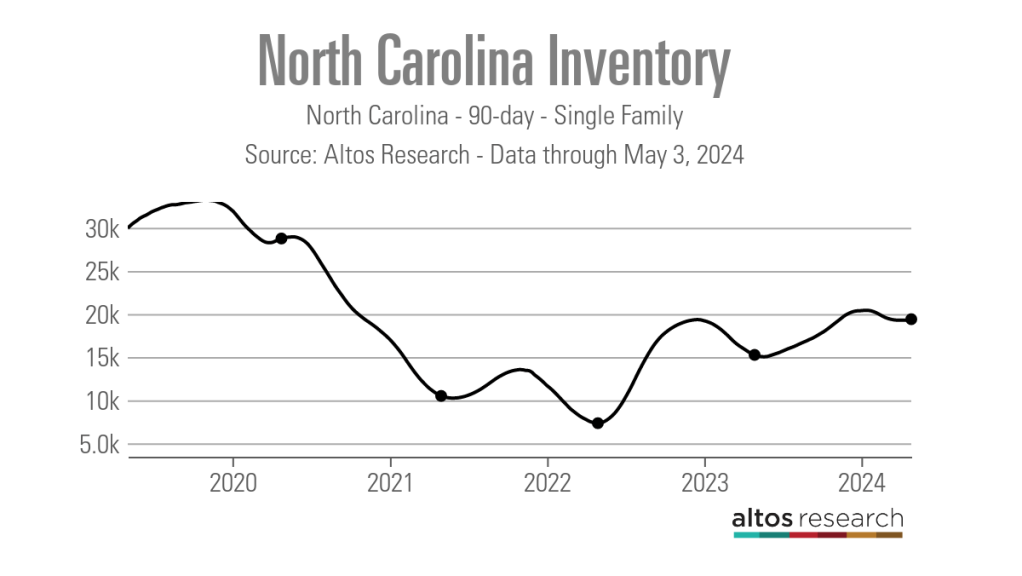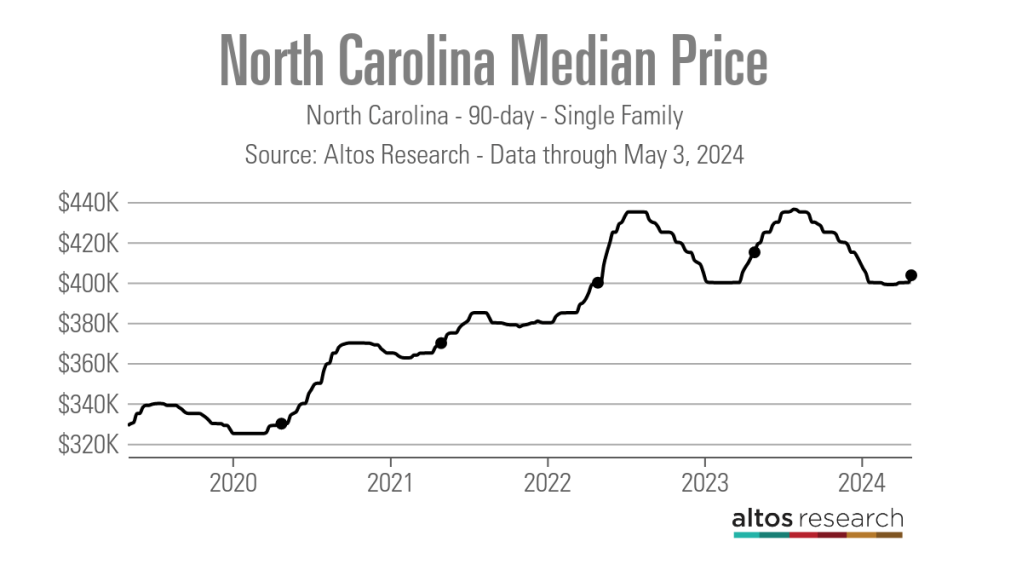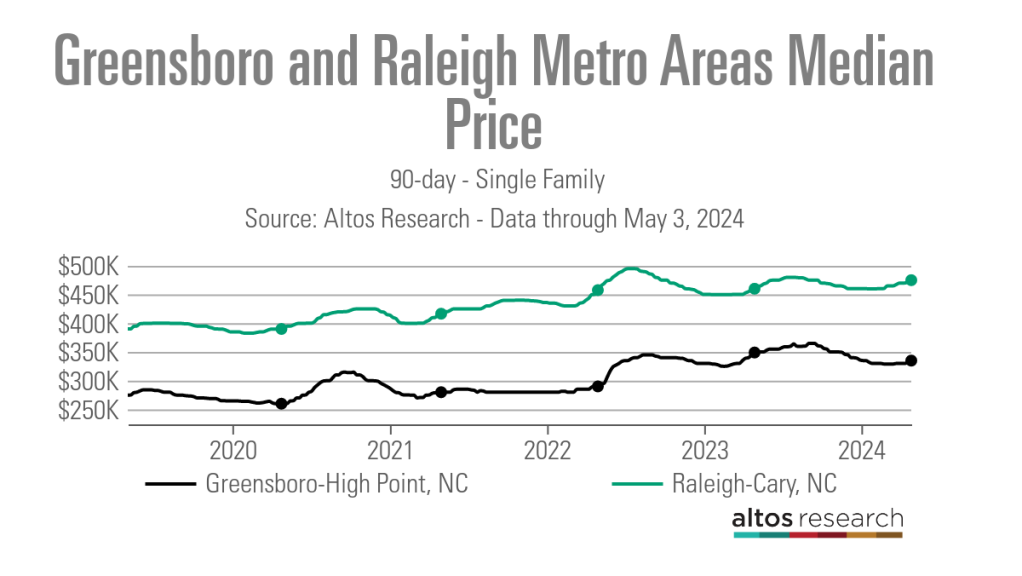No matter where you are in the Tar Heel State, real estate professionals across North Carolina are frustrated by the lack of housing inventory.
“The challenge remains lack of inventory — that’s definitely the big one,” said Alison Alston, the broker-owner of Charlotte-based Lodestone Real Estate and Investments. “We have just not had any luck getting a lot of inventory increase here in Charlotte. We’ve been a sellers’ market here for at least the past eight years, but probably closer to 10 or 11.“
Statewide as of April 26, the 90-day average number of single-family active listings was 19,399, according to data from Altos Research. While this is up from a record low of 7,336 listings set in late April 2022, it is still well below the 29,951 listings in early May 2019, about a year prior to the onset of the COVID-19 pandemic.

On the existing-home market, agents say the lack of inventory is due to a rate-lock effect, as homeowners with mortgage rates at 5% or below are reluctant to give up their rate unless a major life change necessitates a move.
“You have sellers who refinanced their house and they have a 2% interest rate, so why would they then go buy another house for a 7% or even 6.5% rate?” said Robert Cavinder, a broker at Burlington-based Keller Williams Central.
“That is a challenging conversation to have with clients, but basically everyone has equity if they bought their house in the last three or four years. But even if they are looking to use that to make a move, with prices going up, they aren’t really moving up. They are more moving laterally and paying more for that property.”
In addition to a lack of existing-home inventory, North Carolina is also struggling to grow its supply of new single-family homes.
“We have so much new construction happening. Everywhere you look there is a crane, but the problem is the type of inventory being created,” Alston said. “You have a lot of apartment complexes and multifamily units, but there is not as much single-family construction happening, and if it is, it tends to be pretty far outside the city, or it is a custom home that is $2 million on up.”
Andrea Bushnell, the CEO of North Carolina Realtors, said this issue is not just confined to the Charlotte area.
“I was talking to a broker the other day who has two new single-family communities coming online,” she said. “One of them has 11 lots and each of those will be over $800,000, and the other has nine homes and they start at $3.5 million.”
Due to this, Bushnell said the trade organization is working with policymakers on legislation that would allow developers to get some breaks on local regulations in exchange for ensuring that roughly 20% of the homes in a community meet affordable housing pricing standards.
“It didn’t go anywhere last year, but we are going to continue to try,” Bushnell said. “We think that would bring on a lot of development because the builders would be thrilled to be able to get out from underneath some of the regulations they have to face, and it would also allow more consumers to get into the marketplace.”
Compounding the issues created by the state’s lack of inventory is the volume of out-of-state buyers still moving into North Carolina. According to United Van Lines’ 2023 National Movers Study, North Carolina was the No. 6 state for inbound moves, with 60.1% of moves being inbound versus 39.9% being outbound.
The top reasons movers cited for relocating to the state were family (27.2%) and jobs (24.8%). Additionally, an analysis of United Van Lines’ data by Zillow found that two North Carolina cities, Charlotte and Raleigh, were among the top-five U.S. metros with the highest net in-migration in 2023.
“We still have so much relocation business happening,” Alston said. “We get multiple inquiries every day from people all over the country coming to town and wanting to look at some different areas to start looking for properties.”
Local agents say all of this demand, combined with the inventory shortage, continues to cause bidding wars, but negotiations are not as intense as they were at the peak of the post-pandemic housing market.
“If the house is clean and it prices right, there is a very good chance there will be multiple offers, but no way near like 2022, when you’d get seven or eight offers, and we’d actually create a spreadsheet to help the seller look at all of the offers and the terms included in the transaction,” said Phil Misciagno, the managing broker of Hampstead-based Coldwell Banker Seacoast Advantage.
“But right now, as the broker in charge, every weekend, if the house is priced right and move-in ready, I’d expecting one to two offers right away.”
Misciagno added that if homes are at a lower price point and in good condition, there is no doubt they will receive multiple offers.
Although home sellers may not be getting as many offers on their properties, home prices are continuing to accelerate in many markets. On a statewide basis, data from Altos Research shows that the 90-day median average list price was $403,590 as of April 26, down from a peak of $436,365 set in late July 2023 but still well above its May 2019 level of $329,900.

In the hot metro areas of Greensboro-High Point and Raleigh-Cary, the 90-day average median list prices jumped to $334,900 and $474,900, respectively, at the end of April. By comparison, the median list prices in early May 2019 were $275,000 and $389,990, respectively, according to data from Altos Research.

“Greensboro is one of the fastest-growing cities in North Carolina, boasting a job growth rate of 3.2% over the past year,” said Melissa Greer, a broker at Berkshire Hathaway HomeServices Yost & Little Realty. “This influx of new residents is driving up demand for housing.”
Looking ahead to the summer months, real estate professionals across the state expect the housing market to remain strong, and while they would like to see more inventory hit the market, they are not hopeful.
“I think it is going to stay tight through the spring and summer here,” Alston said. “I don’t think we’ll see a significant shift in inventory for at least another 18 months, maybe even a little longer.
“But I expect things to stay pretty competitive here this summer. We usually hit a little bit of a lull in July with the holiday, so I’m anticipating that will still be the case, but I am also anticipating a pretty big push come August and September when school starts back up and people decide they can’t wait another year before moving.”
Although it may be hard for buyers to find a property right now, and interest rates are certainly higher than they were two years ago, Cavinder believes it is a much better time to buy.
“It is a much easier time to buy now because you can actually negotiate,” Cavinder said. “People are actually making repairs found in inspection reports. There is an opportunity in the market that hasn’t been there in the last three years.”












 English (US) ·
English (US) ·